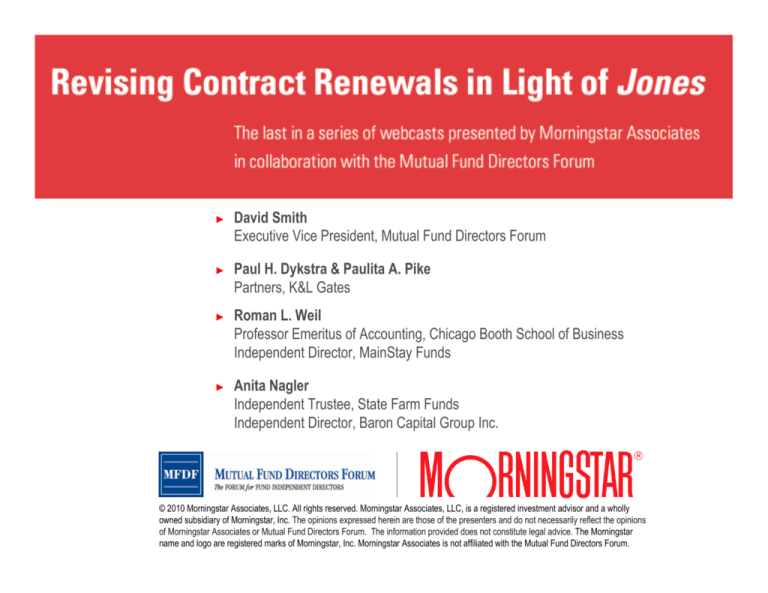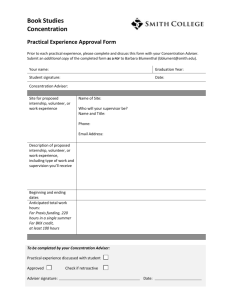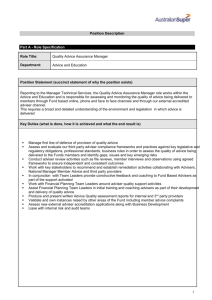
►
►
►
►
David Smith
Executive Vice President, Mutual Fund Directors Forum
Paul H. Dykstra & Paulita A. Pike
Partners, K&L Gates
Roman L. Weil
Professor Emeritus of Accounting, Chicago Booth School of Business
Independent Director, MainStay Funds
Anita Nagler
Independent Trustee, State Farm Funds
Independent Director, Baron Capital Group Inc.
© 2010 Morningstar Associates, LLC. All rights reserved. Morningstar Associates, LLC, is a registered investment advisor and a wholly
owned subsidiary of Morningstar, Inc. The opinions expressed herein are those of the presenters and do not necessarily reflect the opinions
of Morningstar Associates or Mutual Fund Directors Forum. The information provided does not constitute legal advice. The Morningstar
name and logo are registered marks of Morningstar, Inc. Morningstar Associates is not affiliated with the Mutual Fund Directors Forum.
David Smith
Executive Vice President, Mutual Fund Directors Forum
2
Paul H. Dykstra & Paulita A. Pike
Partners, K&L Gates
3
The Decision
►
On March 30, 2010, the Supreme Court issued its highly anticipated decision in Jones v.
Harris Associates, L.P.
►
►
The decision resolves the Circuit split that was created when the Seventh Circuit Court
of Appeals adopted a new, market-based standard for the evaluation of investment
advisory fees under Section 36(b) of the Investment Company Act of 1940.
In a unanimous opinion, the Court concluded that the Second Circuit’s 1982 decision
in Gartenberg “was correct in its basic formulation of what Section 36(b) requires: to
face liability under Section 36(b), an investment adviser must charge a fee that is so
disproportionately large that it bears no reasonable relationship to the services
rendered and could not have been the product of arm’s length bargaining.”
4
Section 36(b) of the 1940 Act
►
Section 36(b) imposes a fiduciary duty on mutual fund advisers with respect to their fees and
authorizes civil actions by the SEC and shareholders for breach of that duty.
►
In Jones, the plaintiffs alleged that fees the adviser charged to the Oakmark Funds were
excessive as compared to fees charged to its institutional clients.
►
The Jones plaintiffs leavened their complaint with allegations that the fee approval
process has been tainted by the presence of directors who were not truly “independent.”
►
The district court, applying Gartenberg and finding that the independent directors met
required independence standards, granted the defendant adviser’s motion for summary
judgment.
►
The plaintiffs appealed, claiming in part that Gartenberg incorrectly interpreted
Section 36(b).
►
The Seventh Circuit affirmed the district court’s grant of summary judgment, but
disapproved of Gartenberg.
5
Judicial Split Among Circuits
►
For over 25 years, Gartenberg served as the predominant framework for judicial and
regulatory interpretations of Section 36(b) and functioned as the nucleus of fund boards’
annual review of investment advisory contracts under Section 15(c) of the Act.
►
Departing from this precedent, Chief Judge Frank Easterbrook wrote for the Seventh Circuit in
Jones that as long as a fiduciary, such as a fund’s adviser, “makes[s] full disclosure and
play[s] no tricks,” that fiduciary generally is free to negotiate its compensation in its own
interest, like any other market participant.
►
Observing that the fiduciary duty standard in Section 36(b) “differs from rate regulation,”
the Seventh Circuit concluded that the statute did not require that advisory fees be
“reasonable” in relation to a “judicially created standard” like that articulated in
Gartenberg.
►
Although the Seventh Circuit acknowledged that it was “possible to imagine
compensation so unusual that a court will infer that deceit must have occurred, or that
the persons responsible for the decision have abdicated” their responsibility, that was
not the case where, as in Jones, fees “are roughly the same…as those that other funds
of similar size and investment goals pay their advisers.”
6
Judicial Split Among Circuits (cont.)
►
The Circuit split created by Jones caused Judge Richard Posner, in a vigorous dissent from
the denial of rehearing by the full Seventh Circuit, to question the substantive standard
required by Section 36(b).
►
According to Judge Posner, the “economic analysis” underlying the panel decision’s
rejection of Gartenberg was “ripe for reexamination” not only because it created a Circuit
split but because of the “importance of the issue to the mutual fund industry.”
►
Subsequent to the Seventh Circuit’s ruling in Jones, and prior to the oral arguments
before the Supreme Court in that case, the Eighth Circuit held in Gallus v. Ameriprise
Financial Inc. that it was error for a district court to reject a comparison of the fees
charged by an investment adviser to its institutional and retail clients.
7
The Supreme Court Weighs In
►
Oral arguments, heard by the Supreme Court in early November 2009, focused on the nature
of the fiduciary duty under Section 36(b); the appropriate standard for measuring advisory fees
and the appropriateness of institutional versus retail advisory fee comparisons in Section 36(b)
inquiries; and the roles of fund boards and courts in Section 36(b) cases.
►
In its Jones opinion, which vacates the Seventh Circuit’s decision, the Supreme Court
embraced the Gartenberg standard as the correct approach in the review of challenged
advisory fees.
►
The Gartenberg framework, Justice Alito wrote for the unanimous Court, accurately
reflects the “delicate compromise” between shareholder and adviser interests that
Congress “embedded in §36(b).”
►
The Court recognized that “while the standard for an investment adviser’s fiduciary duty
has remained an open question in our Court…until the Seventh Circuit’s decision below,
something of a consensus had developed regarding the standard set forth 25 years ago
in Gartenberg.”
►
The Court’s opinion also noted that Gartenberg “has been adopted by other federal
courts, and ‘the SEC’s regulations have recognized, and formalized, Gartenberg-like
factors.’”
8
On Independent Directors
►
The Court’s opinion appears to be a major affirmation of the crucial role of informed and diligent
fund directors in overseeing fees and monitoring conflicts of interest.
►
►
Citing Burks v. Lasker, a case decided by the Court in 1979, the Court observed that
“[u]nder the Act, scrutiny of investment adviser compensation by a fully informed mutual
fund board is the ‘cornerstone of the…effort to control conflicts of interest within mutual
funds’…The Act interposes disinterested directors as ‘independent watchdogs’ of the
relationship between a mutual fund and its adviser.”
The Court also acknowledged that the Act “instructs courts to give board approval of an
adviser’s compensation ‘such consideration…as is deemed appropriate under all the
circumstances.’” The Court noted that from “this formulation, two inferences may be drawn.
►
First, a measure of deference to a board’s judgment may be appropriate in some
instances. Second, the appropriate measure of deference varies depending on the
circumstances.”
9
On Independent Directors (cont.)
►
According to the Court, “Gartenberg heeds these precepts. Gartenberg advises that ‘the
expertise of the independent trustees of a fund, whether they are fully informed about all facts
bearing on the [investment adviser’s] service and fee, and the extent of care and
conscientiousness with which they perform their duties are important factors to be considered in
deciding whether they and the [investment adviser] are guilty of a breach of fiduciary duty…’”
10
On Judicial Review of Board Decisions
►
The Jones opinion focused on the dangers associated with judicial review of a board’s decision
regarding advisory fees.
►
The Court stressed that “where a board’s process for negotiating and reviewing investmentadviser compensation is robust, a reviewing court should afford commensurate deference to the
outcome of the bargaining process.
►
Thus, if the disinterested directors considered the relevant factors, their decision to
approve a particular fee agreement is entitled to considerable weight, even if a court might
weigh the factors differently.”
11
On Judicial Review of Board Decisions (cont.)
►
The Court also considered the possibility that “a fee may be excessive even if it was negotiated
by a board in possession of all relevant information.”
►
In those instances, according to the Court, “a determination [by a court] must be based on
evidence that the fee ‘is so disproportionately large that it bears no reasonable relationship
to the services rendered and could not have been the product of arm’s-length bargaining.’”
►
Addressing a scenario in which “the board’s process was deficient or the adviser withheld
important information,” the Court stated that judicial review of the board’s decision must be
more “rigorous.” In any case, the Court stressed that “Section 36(b) does not call for
judicial second-guessing of informed board decisions.”
12
On Comparative Fees
►
The Court extensively reviewed the role of comparative fees in the Section 36(b) calculus.
►
Commenting on the usefulness of comparing a mutual fund’s advisory fees to the fees
charged by the fund’s adviser to other clients, the Court reasoned that “[s]ince the Act
requires consideration of all relevant factors…we do not think that there can be any
categorical rule regarding the comparisons of the fees charged different types of clients.
►
Instead, courts may give such comparisons the weight that they merit in light of the
similarities and differences between the services that the clients in question require.”
Warning against “inapt comparisons,” the Court noted that:
there may be significant differences between the services provided
by an investment adviser to a mutual fund and those it provides to a pension
fund which are attributable to the greater frequency of shareholder redemptions
in a mutual fund, the higher turnover of mutual fund assets, the more burdensome regulatory and
legal obligations, and the higher marketing costs. If the services rendered are sufficiently different
that a comparison is not probative, then courts must reject such a comparison. Even if the services
provided and the fees charged to an independent fund are relevant, courts should be mindful that
the Act does not necessarily ensure fee parity between mutual funds and institutional clients.
13
On Comparative Fees (cont.)
►
The Court also warned, as did the Gartenberg court, against placing too much emphasis on a
comparison of one fund’s advisory fees against fees charged to other mutual funds by other
advisers.
►
►
“These comparisons are problematic because these fees, like those challenged, may
not be the product of negotiations conducted at arm’s length.”
Moreover, the Court cited Gartenberg for the proposition that “competition between…funds for
shareholder business does not support an inference that competition must therefore also exist
between [investment advisers] for fund business. The former may be vigorous even though
the latter is virtually non-existent.”
14
On Advisers’ Fiduciary Duty
►
A significant portion of the Court’s opinion is dedicated to an exploration of the history of
Section 36(b), which was adopted by Congress in 1970, with the goal of illuminating the
meaning of the statutory statement that an investment adviser “shall be deemed to have a
fiduciary duty with respect to the receipt of compensation for services.”
►
Observing that the meaning of Section 36(b) “is hardly pellucid,” the Court affirmed that
the Gartenberg formulation “was correct.”
►
Citing its 1939 decision in Pepper v. Litton, the Court stated that “the essence of the test
[as to whether a fiduciary duty has been violated] is whether or not under all the
circumstances the transaction carries the earmarks of an arm’s length bargain.”
►
According to the Court, “[t]he Gartenberg approach fully incorporates this understanding of
the fiduciary duty…Gartenberg insists that all relevant circumstances be taken into account…”
►
The Court also highlighted that “[t]he Investment Company Act shifts the burden of proof from
the fiduciary to the party claiming breach,” thus emphasizing that plaintiffs (and not
investment advisers) continue to have the burden of proof when bringing suit under Section
36(b), as acknowledged in Gartenberg.
15
The Court’s Concluding Thoughts
►
The Court concluded its opinion by once more endorsing the principles articulated in
Gartenberg.
►
Noting that the “Gartenberg standard, which the [Seventh Circuit] panel rejected, may lack
sharp analytical clarity,” the Court emphasized that “we believe that it accurately reflects the
compromise that is embodied in Section 36(b), and it has provided a workable standard for
nearly three decades.
►
The debate between the Seventh Circuit panel and the dissent [in that Circuit]…
regarding today’s mutual fund market is a matter for Congress, not the courts.”
16
Roman L. Weil
Professor Emeritus of Accounting, Chicago Booth School of Business
Independent Director, MainStay Funds
roman@uchicago.edu
17
Gartenberg Factor #2: Profitability of the Fund to the Advisor
►
Martin and Chambers of WilmerHale say:
“The Court quotes the Gartenberg factors with approval. The Court did not, however, suggest
a priority consideration of the factors…Academic literature suggests that some of these
factors may not be relevant to assessing whether an advisory fee is excessive for fund
investors.”
“Commentators, for example, have written that the profitability of the fund to an investment
adviser measures the adviser's efficiencies in providing an advisory service and not whether
investors could obtain the same performance and services for a lower price at a competitor.”
“The Court neither acknowledges this debate, nor suggests how the lower courts should
assess fund profitability in investment advisory challenges. There are few judicial
pronouncements about fund profitability, which in turn provide scant guidance to boards
seeking to adhere to the Gartenberg formulation in reviewing investment advisory
agreements.”
18
What SCOTUS Says About Comparisons with Institutional Fees
►
“[C]ourts may give such comparisons the weight that they merit in light of the similarities
and differences between the services that the clients in question require, but courts must be
wary of inapt comparisons. As the panel below noted, there may be significant differences
between the services provided by an investment adviser to a mutual fund and those it
provides to a pension fund which are attributable to the greater frequency of shareholder
redemptions in a mutual fund, the higher turnover of mutual fund assets, the more
burdensome regulatory and legal obligations and higher marketing costs.”
19
Focus is Illusory
►
About profitability, plaintiff advocates [JP Freeman, SL Brown, and S Pomerantz] have said:
“…profitability calculations involve cost allocation issues that are subject to dispute, and there
is no universally accepted methodology for making that analysis…”
1. The authors say methodology, but they mean, merely, methods. Methodology is the
study of methods, not methods themselves. Compare, for example, sexology which is
the study of sex not, alas, sex itself.
2. More important: Not: ‘there is no….’ but “there can be no universally accepted
method…”
►
About profitability, counsel says:
“Don’t worry about profitability; the test is reasonableness, and the business judgment rule.”
►
Your economist asks:
“Where are the objective standards of reasonableness if not from financial analysis?”
►
Counsel doesn’t provide any.
20
The PROBLEM (on line 12)
Measuring Profitability of the Lines of Business and of the Individual Funds
Advisor Has
Mutual Funds
Pension
Funds
Total
Fund A
Allocation Bases
Dollars Managed
800,000
420,000
190,000
Number of Accounts
4
150
100
Average Account Size
200,000
1,900
Interquartile Range of Account size
500,000
1,520
Number of stocks in Fund
350
170
100
Valuation Committee Time
1
107
2
Direct Employees
5
24
10
Direct Payroll
400,000
2,360,000
900,000
Outside auditor charges per fund
5,000
24,000
10,000
Fees for Services ………………………
800
900
400
Direct Costs are $340, $50 for Pension Funds and $290 for Mutual Funds.
1
2
3
4
5
6
7
8
9
10
11
12 Common Costs are $1,100.
Fund B
140,000
40
3,500
2,100
40
5
8
800,000
6,000
300
Fund C
90,000
10
9,000
1,800
30
100
6
660,000
8,000
200
Totals
1,220,000
154
520
108
29
2,760,000
29,000
1,700
21
Allocating Common Costs Using Number of Accounts
Measuring Profitability of the Lines of Business and of the Individual Funds
A dvisor Has
Mutual Funds
P ension
Fund s
1 Numbe r of Accou nts
2 Fees for Services … … ……… …… ……
Total
4
Fund A
150
800
Fund B
1 00
9 00
40
400
Total s
F und C
3 00
10
154
20 0
1 ,7 00
A dvisor Has
Mutual Funds
P ension
Fund s
3
4
5
6
7
8
9
10
11
12
13
14
15
16
17
Total
Fund A
Fund B
Total s
F und C
Fees for Services … … ……… …… ……
800
9 00
400
3 00
20 0
1 ,7 00
Direct Costs ……… …… ……… …… …
Contribu tio n Mar gin …… … ……… ……
50
750
2 90
6 10
120
280
1 10
1 90
60
14 0
3 40
1 ,3 60
29
1 ,0 71
All oca tion o f Indir ect Co sts
To Line s of Busin ess …… …… ……
1 ,1 00
1 ,1 00
To Individu al Fu nds …… …… ……
Pr ofi t Margin … …… ……… … ……… …
P ercentage of Fees … ……… … …
Assets
S pecifi ca lly Id entifi able
Comm on
Rate of R etur n on Assets
714
721
(4 61)
90.2%
2 86
(434 )
(96)
-108.6%
-31.9%
Numbe r of Accou nts
71
1 ,0 71
69
2 60
34.3%
200
5 00
333
1 33
33
7 00
66
2 ,4 84
1,656
6 62
16 6
2 ,5 50
3 ,2 50
271.0%
-1 5.5%
-21.8%
Direct Costs are $34 0, $50 for P ensio n Fu nds and $29 0 for Mu tu al Fund s.
Common Costs are $1,100.
B asis of
Alloca tio n
-12.0%
Numbe r of Accou nts
34.5 %
22
Allocating Common Costs Using Number of Stocks in the Account
Measuring Profitability of the Lines of Business and of the Individual Funds
Adviso r Has
Mutua l Funds
Pension
Fun ds
1
2
Nu mber of stocks in Fund
Fe es for Service s ………………………
Total
350
800
Fund A
170
900
Fun d B
100
400
40
3 00
Totals
Fund C
30
200
520
1 ,700
Adviso r Has
Mutua l Funds
Pension
Fun ds
3
4
5
6
7
8
9
10
11
12
13
14
15
16
Fe es for Service s ………………………
Di rect Costs ……………………………
Co ntribu tion Margin ……………………
Allocation o f Indi rect Costs
To Lines of Business ………………
To Individu al Funds ………………
Profit Margin ……………………………
P ercentage of Fees ………………
Assets
S pecifically Identifiable
Common
17
Common Costs are $1,100.
Total
Fund A
800
50
750
900
290
610
740
360
10
250
1.2%
200
1,716
500
834
400
120
280
Fun d B
3 00
1 10
1 90
Totals
Fund C
200
60
140
1 ,700
340
1 ,360
1,1 00
1,1 00
212
68
85
1 05
17.1%
35.1%
3 8.3 %
294
490
1 18
1 96
88
147
33.6%
32 .5%
Rate of Return on Assets
0.5%
18.8%
8.7%
Di rect Costs are $340, $50 for Pension Funds a nd $290 for Mu tual Funds.
63
77
Basis of
Allocation
Numbe r of Stocks in Fu nd
360
260
700
2 ,550 Numbe r of Stocks in Fu nd
3 ,250
23
Allocating Common Costs Using Ability to Bear
Measuring Profitability of the Lines of Business and of the Individual Funds
Adviso r Has
Mutua l Funds
Ability to Bear
Pension
Fun ds
1 Fe es for Service s ………………………
Total
800
Fund A
900
Fun d B
400
3 00
Totals
Fund C
200
1 ,700
Adviso r Has
Mutua l Funds
Pension
Fun ds
2
3
4
5
6
7
8
9
10
11
12
13
14
15
16
17
Fe es for Service s ………………………
Di rect Costs ……………………………
Co ntribu tion Margin ……………………
Allocation o f Indi rect Costs
To Lines of Business ………………
To Individu al Funds ………………
Profit Margin ……………………………
P ercentage of Fees ………………
Assets
S pecifically Identifiable
Common
Total
Fund A
800
50
750
900
290
610
607
493
400
120
280
3 00
1 10
1 90
Totals
Fund C
200
60
140
226
54
1 54
36
113
27
143
117
19.1%
19 .1%
19.1%
19.1%
1 9.1 %
17.9%
13.0%
13.4%
12.1%
13 .4%
200
1,406
500
1,144
230
525
1 56
3 56
115
263
10.2%
10 .2%
Basis of
Allocation
1 ,700
340
1 ,360
1,1 00
1,1 00
Rate of Return on Assets
10.2%
10.2%
10.2%
Di rect Costs are $340, $50 for Pension Funds a nd $290 for Mu tual Funds.
Common Costs are $1,10 0.
Fun d B
493
260
=
Contributi on Margi n
Called "Ability to Bear"
Profits/Contribution Mar gin
700
2 ,550
3 ,250
Contributi on Margi n
Called "Ability to Bear"
24
Allocation Bases are Many, Arbitrary, and Selection Matters
►
In the original Gartenberg case, experts for the plaintiff found the advisor enjoyed profits of 38
percent, while those for the defense found the funds suffered a loss.
Factors
Allocation Bases
Dollars Managed
Number of Accounts
Average Account Size
Interquartile Range of Account size
Number of stocks in Fund
Valuation Committee Time
Direct Employees
Direct Payroll
Outside auditor charges per fund
25
Which Ratio to Use to Assess Profitability?
Three Companies; Three Ratios Exercise
Revenues …………………… R
$
Income Before Interest
and Taxes ………………… YBIT
Net Income …………………… Y
Average During Year
Total Assets ………………… A
Common Shareholders'
Equity ……………………… SE
Big
Company
Medium
Small
A
Se
Sa
28.95
4.30
2.92
$
13.64
0.82
0.52
$
9.72
7.89
1.83
29.77
5.12
0.74
I. Profit Margin Ratio = Y/R …………
10.1%
3.8%
1.5%
II. Rate of Return on
Assets = YBIT/A ……………………
5.6%
10.4%
8.5%
III. Rate of Return on
Shareholders' Equity = Y/SE ……
9.8%
10.2%
20.0%
Sears
►
It takes more data to do
ROA, but not hard data, and
►
It requires allocations of fixed
costs, but no more or less
arbitrary than the allocations
already required to compute
profit margins.
0.16
0.15
77.11
AT&T
ROA beats Profit Margin
even though:
Safeway
26
24 Omitted Words
“If you are going to endorse Gartenberg standard, please throw out the profitability test, as it
has no economic nor other theoretically sound basis. “
27
Directors Should Consider…
►
Asking management for sensitivity analyses of the profitability measures they show us.
►
Starting process of assessing profitability of institutional line of business v. mutual fund family.
►
Being prepared to start addressing the Freeman, Brown, Pomerantz analysis of the fees of
advisors who charge different [much higher] fees to their own funds than to Vanguard for subadvising the same sort of funds.
Table 3 of their article shows:
1
2
3
Assets Managed in Millions
$ 10 $ 100 $ 1,000 $ 10,000 $ 25,000
Captive Fund Mean in bps ……… 70
69
66
64
63
Vanguard Mean in bps …………… 29
27
22
15
14
See, also, William Baumol’s 1990 book.
28
Q&A
Please type in your question using the Q&A button at the top of the screen
29
For More Information
Please contact Paul Ellenbogen at paul.ellenbogen@morningstar.com
30





![Literature Option [doc] - Department of French and Italian](http://s3.studylib.net/store/data/006916848_1-f8194c2266edb737cddebfb8fa0250f1-300x300.png)






